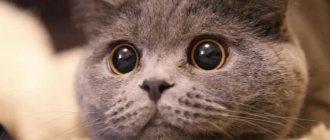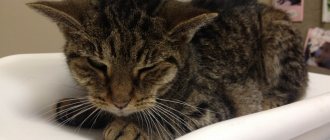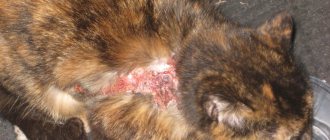The thinnest mucous membrane covering the eyeballs, as well as the eyelids on the inside, is called the conjunctiva. In the area of the upper eyelid it is thicker, like a pad. Contains accessory lacrimal glands, the purpose of which is to protect the eye from drying out. In addition, tears perform a protective function - washing away small foreign bodies.
Conjunctivitis in cats, like in humans, is an inflammation of the conjunctiva. Based on the clinical picture, the disease is classified into types, each of which is characterized by certain symptoms. In addition, various factors can trigger the development of the disease. Therapeutic actions are determined by the type of disease and its course.
Reasons why cats' eyes often water
Active lacrimation in cats can be caused by direct and indirect (indirect) factors. In the first case, the release of fluid is associated with injury to the eyeballs, entropion of the eyelid, penetration of a foreign body, inflammation of the mucous membrane and eyelid, radiation or chemical burns of the eyes, etc.
Some cats have hereditary or traumatic deformities of the eyes and nasolacrimal grooves, which leads to constant tear production and dramatically increases the risk of secondary bacterial inflammation.
With indirect damage, lacrimation is a symptom of another disease occurring in the animal’s body. The underlying disease may be rhinotracheitis, feline herpes, calcivirosis, allergic reaction, parasitic infestation, etc.
What is conjunctiva and conjunctivitis
The conjunctiva is the mucous membrane that lines the inside of the eyelids and the eyeball. It is thin over almost the entire surface, but thickens under the upper eyelid, which allows you to avoid deep tissue damage when a foreign object (grains of sand, small insects, etc.) enters.
Additional tear ducts are located on the conjunctiva, so when there is mechanical damage to the mucous membrane or an inflammatory process, lacrimation immediately occurs.
Near the inner corner of the eyes in cats there is a semilunar fold (third eyelid). Normally, it is practically invisible, but when the mucous lining is inflamed, it covers a large area of the eye.
With conjunctivitis, active substances (histamine, etc.) provoke an influx of leukocytes into the area of infection. The production of inflammatory mediators can be a normal reaction to the penetration of pathogenic microflora or an autoimmune process in which the body attacks its own tissues. As a result, swelling of the mucous membrane and the entire eye occurs.
Against the background of the loss of the protective function of the conjunctiva, the functionality of the entire eye decreases: first of all, normal perception of light. General signs of inflammation and intoxication are also noted.
Conjunctivitis, contagious or not
There are various forms of the disease, each of them has its own degree of contagiousness:
- viral - spreads quickly among people, for this you need to be near an infected person for a short period of time;
- bacterial - does not spread so quickly, this requires contact with an infected patient;
- allergic, mechanical - does not spread to other people, since the disease is caused by damage to the mucous membrane, and not by a pathogenic microorganism;
- fungal - typical for people who have immunodeficiency; the pathogens do not spread to other people.
Viral and bacterial forms spread easily among people; this requires a certain route of transmission of the pathogen.
Types of conjunctivitis
Inflammation of the conjunctiva can be catarrhal, purulent, follicular and phlegmonous. Some doctors distinguish viral conjunctivitis as a separate type, because this etiological factor determines the indirect nature of the disease.
Catarrhal
Catarrhal conjunctivitis is the most common type of inflammation. Its diagnostic criterion is the presence of general symptoms of inflammation of the membrane and the release of mucous, almost transparent exudate. If you contact a veterinarian in a timely manner, this type of disease is highly treatable. If left untreated, catarrhal inflammation can be complicated by secondary infection and purulent conjunctivitis.
Acute inflammation can also become chronic. It is characterized by the constant release of exudate, which forms crusts and irritates the skin around the animal’s eyes. Chronic catarrhal conjunctivitis often develops against the background of a genetic predisposition (breed characteristics), abnormalities in the structure of the eye and other risk factors.
Purulent
Purulent conjunctivitis in cats develops due to infection of the mucous bacterial flora. The waste products of microbes and leukocytes that fight infection cause the turbidity and yellowish color of the discharge. In some cases, the pus may have a green tint.
At the initial stages of inflammation, there is no excessive release of exudate, so inflammation can be suspected by the formation of yellow crusts in the cat’s eyes after sleep.
Purulent inflammation occurs with severe intoxication, so it can manifest itself as fever and a rapid deterioration in the animal’s general well-being. If left untreated, the infection spreads to surrounding tissues, which can lead to blindness or even death of the pet.
Phlegmonous
Phlegmonous (parenchymatous) conjunctivitis is a complicated subtype of purulent. It occurs like an abscess (phlegmon), because. bacterial exudate is not completely released out, but accumulates under the mucous membrane. Inflammation spreads from the conjunctiva to the subconjunctival tissue.
Affected tissues often bleed even with slight mechanical impact, so it is important to differentiate conjunctivitis from hematoma and eye injury. A serous-purulent film may form on the surface of the mucosa, and later a scab, which, when damaged, causes extensive bleeding from the subconjunctival tissues.
Conjunctivitis differs from purulent dacryoadenitis (inflammation of the lacrimal gland) and phlegmon by a larger area of tissue damage. Due to the peculiarities of the course of the disease, phlegmonous conjunctivitis requires treatment in a veterinary hospital.
Follicular
With follicular conjunctivitis, inflammation spreads not only to the mucous membrane, but also to the lymphatic follicles located on the semilunar fold. Most often, this disease is associated with foreign bodies, eye injury and complications of catarrhal inflammation. The secreted exudate is mucous, and when a secondary infection is attached, it is mucopurulent.
A risk factor for the development of follicular conjunctivitis in cats is a lack of vitamins and microelements. If left untreated, eyelid ectropion develops, the integrity of the membranes of the eye is disrupted, and vision deteriorates.
Viral
Viral conjunctivitis occurs as a concomitant disorder with herpes, adenovirus infection and other diseases. Inflammation of the mucous membrane occurs according to the catarrhal type.
The main treatment method is to eliminate the root cause of conjunctivitis (viral infection). For this purpose, immunomodulators and antiviral drugs are used. Symptomatic treatment of eye complications is carried out according to the type of treatment of catarrhal conjunctivitis.
Other types of conjunctivitis
In addition to the listed diseases, the following types of conjunctivitis are distinguished in veterinary practice:
- Fibrinous. With this disease, fibrin films form on the animal's conjunctiva. Underneath them, necrosis of mucosal tissue and subconjunctival structures occurs. Fibrinous inflammation can be lobar and diphtheroid. In case of lobar necrosis, only the superficial layers of the mucosa are affected, while in case of diphtheroid necrosis, it is deep, right down to the parenchyma. The disease develops with infections and severe non-thermal burns.
- Eosinophilic. In this form of the disease, white-pink or white plaques consisting of eosinophils (a specific type of leukocyte) are deposited on the mucous membrane of the eye. The pathology is autoimmune in nature and most often occurs in animals infected with the feline herpes virus. This pathogen provokes the development of rhinotracheitis.
- Chlamydial. Conjunctivitis caused by parasites (chlamydia) occurs as a purulent type. Blood impurities are found in the purulent exudate. Chlamydia can be transmitted sexually, through animal contact, and from mother cat to kitten. If left untreated, the disease affects the eyes and then the mucous membranes of the nasopharynx.
What causes you to get viral conjunctivitis?
Viral conjunctivitis is considered the most dangerous infectious form of the disease. It freely “passes” from one person to another. Several factors contribute to the spread of this form of the disease, including:
- contact with a sick person;
- using shared hygiene items;
- ingestion of tears or saliva from a sick person;
- sexual contact with an infected person.
A pregnant woman can become a carrier of viral conjunctivitis. To do this, she does not have to suffer from this pathology. This form of the disease can be transmitted to a newborn if his mother suffered from gonorrhea or chlamydia. Viral conjunctivitis is included in the group of highly contagious diseases. This means that you can get sick very quickly if a person has had contact with an infected person. The incubation period takes from 3 to 5 days. When an infection enters the body, both eyes are affected simultaneously. This form of pathology often begins to develop in the autumn-winter period. This is due to the increase in colds of the upper respiratory tract, otitis media, sinusitis, and tonsillitis.
ARVI and other colds are not the only ailments that can lead to the development of viral conjunctivitis. From one person to another, this disease can be transmitted with the viruses of herpes simplex and herpes zoster, chickenpox, measles, enteroviruses, etc. In most cases, children suffer from viral conjunctivitis. Especially often - preschool age. “Outbreaks” of this disease often occur in kindergartens and schools, despite the fact that children are told about how they can get conjunctivitis.
Causes
The causes of conjunctivitis can be:
- eye injuries and bruises, eyelid defects (eversion or entropion);
- foreign objects entering under the eyelid;
- radiation burn;
- eye irritation from caustic chemicals (chemical burn);
- parasitic infestation;
- systemic infectious disease (most often of viral etiology);
- eye contamination, bacterial infection of a wound due to injury, secondary infection due to non-bacterial conjunctivitis;
- spread of inflammation from nearby tissues (lacrimal sacs, cornea, less often - nasopharynx);
- allergic reactions.
Predisposing factors for the development of the disease are:
- characteristics of the breed (for example, Persian cats have incomplete closure of the eyelids, which increases the risk of inflammation);
- post-traumatic changes in the anatomy of the eye;
- hypofunction of the lacrimal gland (dry eye syndrome);
- hypo- and vitamin deficiency;
- weakened immunity due to systemic infection.
Symptoms and signs
Symptoms of conjunctivitis in cats vary depending on the type of disease. The following signs are common to all types of inflammation:
- redness of the conjunctiva;
- the appearance of a semilunar fold, edema (swelling) and eversion of both eyelids, in some cases - clouding of the eyes;
- pain in the eyes, and in some cases in the periocular area;
- active lacrimation;
- mucous, cloudy (serous), bloody, white or yellow (purulent) discharge from the eyes;
- photophobia;
- the animal's desire to rub its eyes with its paw;
- with a pronounced infectious process - apathy, the animal’s desire to hide in a secluded place, loss of appetite, increased body temperature (normal temperature in cats is +37.5..+39°C, in kittens - up to +39.5°C).
Treatment at home
Treatment at home can only begin after visiting a veterinarian. The doctor prescribes medications and procedures based on the etiology and nature of the disease. It is important to note that with unilateral lesions, treatment is prescribed for both eyes.
The main goals of therapy are:
- elimination of the root cause of inflammation (removal of a foreign body followed by antiseptic treatment, treatment of a viral disease, cessation of contact with the allergen, etc.);
- treatment or prevention of bacterial inflammation;
- symptomatic therapy with decongestants, local anesthetics and other drugs.
Drug therapy may include the following medications:
- local painkillers (Dicain 0.3%, Novocain 2% - no more than 5 days);
- decongestants (Dexamethasone for no more than 10-14 days);
- antibacterial drops for conjunctivitis in cats (Tsiprovet, Bars, Iris, Conjunctivin, Lakrikan, Sofradex);
- ointments with antibiotics (tetracycline, Optimmune, Mizofen, Conjunctivin);
- systemic antiviral drugs (Anandin, Dostim, RBS, Polyferrin-A, Roncoleukin);
- antihistamines (for allergic conjunctivitis - Terfenadine, Fenistil, Cetirizine);
- vitamin complexes (Aminovit, Gamavit);
- in some cases - human ophthalmic drops, except for preparations with sodium sulfacyl (Floxal, Tobrex, Tsiprolet, etc.).
In case of acute bacterial inflammation or the presence of complications, injectable antibiotics are used (Tsiprovet, Tetracycline, Erythromycin). For chronic conjunctivitis, preparations of emulsified tissues (TES-normin, Placentol) are also prescribed.
Some procedures are carried out only in a veterinary clinic. These include not only eye surgeries for severe complications of conjunctivitis, but also the following manipulations:
- removal of sharp and large foreign bodies from the eye, treatment of a wound or bruise;
- performing retrobulbar blockade with Novocaine in case of damage to the eyeball;
- cauterization of follicles with silver nitrate preparations for follicular inflammation;
- intravenous injections.
The eyes of a sick cat can be gently wiped with a sponge generously moistened with rinsing solution. For the procedures, you should use saline solution, highly diluted aloe juice, Furacilin solution (1 tablet per 1 glass of water) and weak infusions of chamomile, calendula, dill or rose hips. It is not recommended to use black tea or potassium permanganate for eye care.
Removing fibrinous films when treating an animal is strictly prohibited. To facilitate spontaneous separation of the films, you can make warm herbal compresses for the eyes.
How to prevent infection
If a person has been in contact with an infected person, one should resort to rules that will not allow pathogenic microorganisms to spread through organs and tissues:
- if conjunctivitis was caused by a virus, antiviral agents should be used prophylactically;
- if the disease is caused by a bacteria, antibiotics are not used, only antiseptics are used so that microorganisms do not develop resistance;
- the use of multivitamins, which activate the body’s defenses, accelerate metabolism and regeneration of damaged tissues;
- using bactericidal soap, gel, wipes after contact with an infected person to prevent the infection from spreading to other surfaces;
- upon arriving home, you should take a shower with bactericidal soap; the use of hot baths is not recommended, since bacteria and viruses spread faster in stagnant water;
- treatment of the nose and throat with a bactericidal agent (Furacilin, soda, Albucid), since these areas are the entrance gates for pathogenic microorganisms.
Applying the above rules does not always help. This is due to the fact that the patient may have reduced immune system function, so even a small penetration of a pathogenic microorganism causes infection and spread of infection to the eyes.
In children, the disease develops much faster, so prevention methods should be resorted to in a timely manner.
Prevention
To prevent conjunctivitis in a cat, you need to:
- feed the animal with balanced food;
- regularly carry out deworming, vaccination and vitamin courses;
- prevent fights with other pets, contact with homeless and wild animals;
- promptly treat viral diseases;
- regularly carry out wet cleaning of the house or apartment, clean the cat litter immediately after contamination;
- store caustic chemicals (solvents, household chemicals, etc.) out of reach of the cat and prevent close contact with perfumes, cosmetics and UV lamps;
- monitor the condition and well-being of the animal.
Can humans get feline conjunctivitis?
When a pet gets sick, most owners wonder whether it is possible to get conjunctivitis from a cat. With infectious inflammation and close contact between humans and animals, transmission of pathogens is possible, although it is observed infrequently. The highest risk of infection exists with primary or secondary bacterial conjunctivitis.
To prevent infection, it is necessary to treat the eyes of a sick cat using medical gloves or wash your hands thoroughly after treatment procedures. It is advisable to isolate children from the pet until it has fully recovered.
How is it transmitted?
The viral form of the disease is characterized by the following transmission routes:
- airborne droplets through sneezing, coughing and even talking;
- during physical contact with the patient, for example when shaking hands;
- when using common personal hygiene or household items (dishes, towels, handkerchiefs, cosmetics);
- vertical transmission route, that is, from mother to child, which can occur during the prenatal period or during birth.
If a patient is infected with bacterial conjunctivitis, airborne transmission is rare. Otherwise, the transmission routes are repeated and supplemented by the following factors:
- sexual intercourse, for example, chlamydial infection is often transmitted through oral sex;
- lack of personal hygiene rules when a person came into contact with an infected patient and did not wash his hands with bactericidal soap afterwards.
Some pathogens, once entering the human body, remain there forever. Such microorganisms include herpes, which is concentrated in the nervous tissue and is activated under the influence of negative environmental factors.
Infection after contact with a sick person does not always occur. Microbes and viruses can get on a person, but the disease does not form. This requires normal functioning of the immune system. If a person is exposed to negative environmental factors, the disease will develop.











